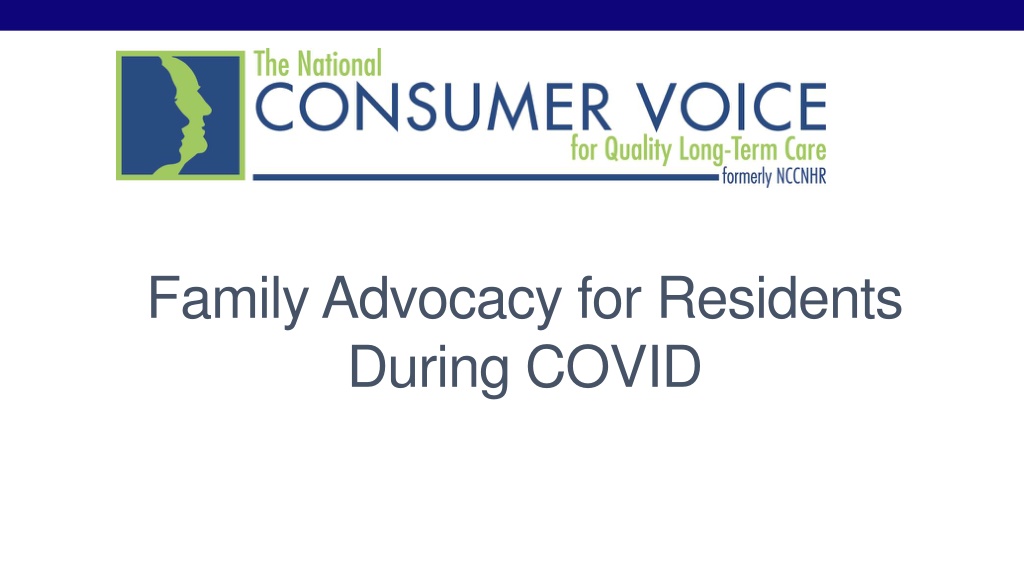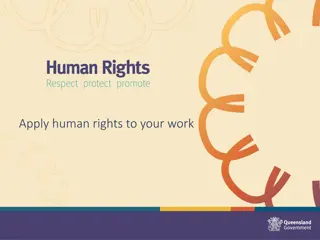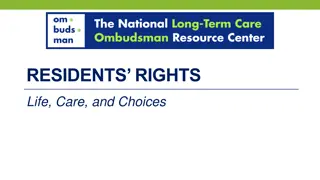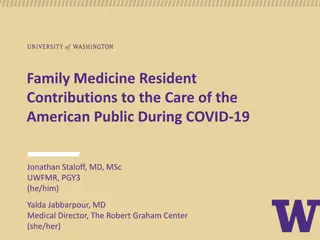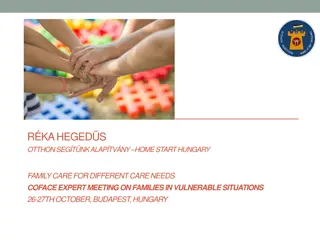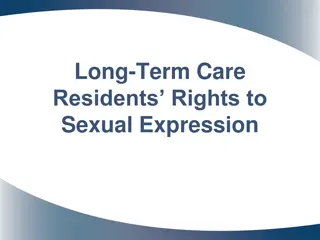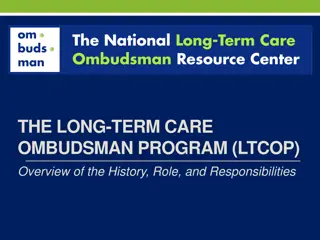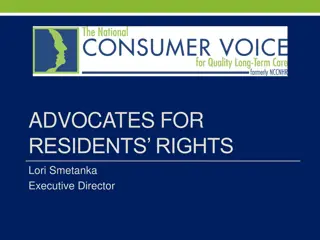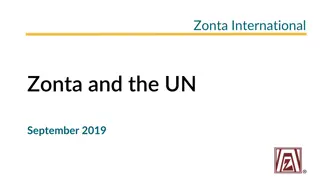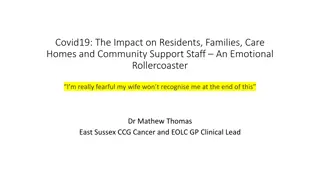Empowering Families: Advocating for Residents' Rights During COVID
The guide focuses on empowering families to advocate for the rights of nursing home or assisted living facility residents during the COVID-19 pandemic. It discusses roles, common situations, residents' rights, and individual advocacy steps, including working with facilities and contacting ombudsmen or elected officials for support.
Download Presentation

Please find below an Image/Link to download the presentation.
The content on the website is provided AS IS for your information and personal use only. It may not be sold, licensed, or shared on other websites without obtaining consent from the author. Download presentation by click this link. If you encounter any issues during the download, it is possible that the publisher has removed the file from their server.
E N D
Presentation Transcript
Family Advocacy for Residents During COVID
How would you describe your primary role: Family member of a nursing home resident/assisted living facility resident/individual receiving services at home Resident of a nursing home/assisted living facility/ individual receiving services at home Long-term care ombudsman Individual citizen advocate Member of a citizen advocacy group Other
Agenda How to advocate on behalf of a loved one and other residents Individually Through a Family Council Long-Term Care Ombudsman Program II. Common Situations Visitation Transfers/discharges Going outside/leaving the facility Transparency Testing III. Advocating Together IV. Q&A/discussion I.
Residents Rights Despite the pandemic, residents still have the right to: Receive care and services to obtain highest level of well-being Participate in the development and implementation of a person- centered plan of care, including the right to make decisions about care now and in the future Be free from abuse, neglect, exploitation, and misappropriation of property Voice grievances without discrimination or retaliation and prompt efforts by the facility to solve their grievances
INDIVIDUAL ADVOCACY What can you do to help your family member?
Individual Advocacy Work with your facility! Speak regularly with administration and staff Ask what they are doing to keep residents safe Insist on regular updates to all families Care planning conference File a grievance with the facility
Individual Advocacy Ombudsmen Contact the ombudsman program in your state to assist you https://theconsumervoice.org/get_help State Survey Agency Limited BUT still file complaints Elected Officials They need to know what s happening in their district/state https://www.house.gov/representatives/find-your-representative Media Write letters to the editor, reach out to local media, use social media
Individual Advocacy Share Your Story: https://theconsumervoice.org/issues/other-issues-and- resources/covid-19/residents-families/share-your-story
What a Family Council Is A self-led self-determining group of families and friends of nursing home residents that: Works to improve the quality of care and quality of life of the facility s residents; and Provides families with a voice in decision-making that affects them and their loved ones.
What Family Councils Do Act on concerns and complaints affecting nursing home residents Advocate for positive change within the facility and the long-term care system Communicate with the nursing home administrator and staff Serve as a sounding board and advisory body on new ideas and improvements Educate and inform families about issues relating to residents, the nursing home, and the long-term care system Provide support to family members
Family Council Rights A resident s family has the right to meet in the facility with the families of other residents in the facility. The facility must provide a family group, if one exists, with private space. Staff or visitors may attend meetings only at the group s invitation. The facility must provide a designated staff person responsible for providing assistance and responding to written requests that result from group meetings. Staff person must be approved by the family group and the facility When a family group exists, the facility must listen to the views and act upon the grievances and recommendations of residents and families concerning proposed policy and operational decisions affecting resident care and life in the facility. The facility must be able to demonstrate their response and rationale for such response. This does not mean the facility must implement as recommended every request of the family group.
Starting a Family Council Find out if there is a family council in your loved one s facility If not, start one! Develop a flyer announcing the formation of a family council; put your name and contact information on it Ask the administrator to send your flyer to family members Contact the Long-Term Care Ombudsman Program for assistance Create a Facebook group to attract family members; communicate directly with them about forming a family council Be creative and innovative: One family member handed out flyers at the facility s laundry pick up/drop off area.
Build Your Family Council: Resources Consumer Voice Family Council Center Long-Term Care Ombudsman Program
What is the State LTC Ombudsman Program? Patty Ducayet, Texas State LTC Ombudsman LTC Ombudsmen represent the interests of residents Receive complaints from anyone on behalf of a resident
Advocating With an LTC Ombudsman Individual problems Facility and corporate management Coordinating with other agencies Systemic problems Media Lawmakers State survey agency National organizations
COMMON SITUATIONS: WHAT YOU NEED TO KNOW!
Visitation CMS Guidance, March 13, 2020 https://www.cms.gov/files/document/qso-20-14-nh-revised.pdf Facilities should restrict visitation of all visitors and non-essential health care personnel, except for certain compassionate care situations, such as an end-of-life situation. Decisions about visitation during an end of life situation should be made on a case by case basis,
CMS Frequently Asked Questions, April 24, 2020 https://www.cms.gov/files/document/qso-20-28-nh.pdf 4. Q: The CMS memorandum (QSO-20-14-NH (Revised)) states that visitation should be allowed in certain compassionate care situations, such as an end-of-life situation. What is an example of a compassionate care situation ? A: The memorandum intends to provide general guidance on how to limit visitation as much as possible, while also acknowledging that there are times when visits should be allowed. We encourage frequent communication among patients, residents, families, facilities, and other health care providers when appropriate (e.g., hospice providers), so they can work together to identify when a visit for compassionate care is needed, and can be safely conducted. One example of such a situation is one in which a resident is receiving hospice care and their health status is sharply declining, or when a resident is not enrolled in hospice, but their health status has sharply declined.
Visitation: Advocacy Strategies Individually: Make the case that your loved one s situation fits the criteria for a compassionate care situation Family Council: Urge the facility to expand its definition of a compassionate care situation Try to work with administration to develop a plan for a phased-in approach to allowing visitation Individually and with Family Council: Determine where your state is with developing reopening guidance Provide input, help shape the guidance
Transfers/Discharges Federal nursing home regulations provide protections: Advance written notice, generally 30 days prior to date of proposed transfer/discharge Right to appeal hearing in front of administrative law judge
Waiver of These Regulations in Only 3 Situations: 1. Resident with COVID-19 transferred to COVID-dedicated facility 2. Resident without COVID-19 transferred to Non-COVID facility 3. Transfer for 14-day observation
23 What Does This Mean? [W]e are only waiving the requirement for the written notice of transfer or discharge to be provided before the transfer or discharge. This notice must be provided as soon as practicable. CMS, COVID-19 Emergency Declaration Blanket Waivers for Health Care Providers.
Residents Still Have Rights Right to: Choice of where to be transferred/discharged Sufficient preparation and orientation to ensure a safe and orderly transfer
Transfers/Discharges: Advocacy Strategies Individually: Request the transfer be stopped for the moment; ask for a meeting to discuss options Individually and with Family Council: Advocate at both the facility and state level for: Advance notice (at least 72 hours) Advance conversation to explore options/make plans
LEAVING A FACILITY DURING COVID-19 Going to a shared courtyard Going for a walk or out for lunch Going home with a family member for the duration
My mother wants to go outside to the courtyard! If the facility has no active cases of COVID-19, there is no CMS guidance that says she can t! FAQ QSO-20-28-NH https://www.cms.gov/files/document/qso-20-28-nh.pdf Can a resident leave a nursing home for an appointment or outside activity? With regard to outside activities, the CMS memorandum (QSO-20-14-NH (Revised)) states that facilities should cancel all group activities such as internal and external group activities. This means there should be no group activities occurring outside or inside of the building, due to the risk of transmission.
Yes, going outside on facility grounds should be permitted! There are facilities in some states that are starting to have outdoor visitation. There are facilities that are allowing smokers to go outside. As long as residents practice social distancing when outdoors they should be permitted to enjoy outdoor spaces. Outdoor recreation is encouraged during this time, it shouldn t be different for residents of long term care facilities.
What can you do? Talk to the facility Bring this up at a care planning meeting Get your ombudsman involved
My mother wants to go for a walk away from the facility or to lunch at a nearby restaurant. Can she? QSO-20-28-NH https://www.cms.gov/files/document/qso-20-28-nh.pdf What if a resident wants to leave the nursing home against medical advice? It is unlawful for a facility to detain and stop a resident from leaving the facility if the resident wishes to leave . If a resident insists on leaving against medical advice, the facility must allow them to leave, should encourage them to wear a facemask while out in the community, discuss the importance of handwashing, offer hand sanitizer if available, and document in the resident s medical record how the facility discouraged leaving and explained the risks of leaving to the resident and/or resident representative. For a resident who leaves and intends to return, the facility should monitor the resident upon return for fever and signs and symptoms of respiratory infection for 14 days (preferably in a space dedicated for observation of asymptomatic residents), and implement the necessary Transmission-Based Precautions if the resident develops fever or signs and symptoms of respiratory infection.
So what does this mean? Your loved one CAN leave their facility! BUT They may be quarantined and monitored for 14 days upon return. They may be asked/required to take tests to determine their COVID-19 status. The facility may push back and not want to let them back in!
What can you do? Discuss the decision with the facility BEFORE your loved one leaves. Understand their policies. Accept that monitoring and quarantine may be done for the safety of everyone within the facility. Once someone leaves the facility grounds, it s impossible to control where they go or whether they practice social distancing. If you are uncomfortable with what the facility is requiring contact your ombudsman!
Can I take my mother home for the duration of the pandemic? Yes! But, there are many things to consider. Does your loved one want to leave? Residents have the right to leave the facility and reside somewhere else! Talk to the facility about whether your mother can return and get it in writing!!! If her care is covered by Medicaid, what are your rights for holding her bed and her return in the future? Is your home equipped for mother s needs? Consider: A special bed or other equipment shower chair, wheelchair, elevated toilet seat Stairs and her ability to maneuver around the house Bathing, toileting, eating Lifting and Transferring in and out of bed or chairs will a second person be needed?
Is someone available to provide 24/7 care if needed? If you need outside help, how will you pay for it? Is there a risk of exposure to COVID-19 Is everyone in your household practicing social distancing? What if someone gets infected while she s with you? Who will oversee her medical care and medications? In the nursing home residents often rely on a medical director, will you be able to find a doctor in your community? What if your mother becomes more ill in your home or needs more care than you can provide? Will you be able to bring in additional help? Will she need to return to a long-term care facility and if so, can she return to the facility where she currently lives? See our checklist: http://eldermistreatment.usc.edu/wp- content/uploads/2020/06/CV_TakingAResidentHome.pdf
TRANSPARENCY DURING COVID-19 What does the facility have to report? What should I be asking? Where else can I find information?
What does the facility have to report? FEDERAL REQUIREMENTS Required to report to families, residents, and resident representatives: (by 5pm the next calendar day, following the occurrence of or weekly) Single confirmed infection OR Three or more residents or staff with new onset respiratory symptoms occurring within 72 hours of each other Actions they are taking to mitigate the spread of the virus Required to report to CMS: (at least weekly) Suspected and confirmed COVID-19 cases among residents and staff Total deaths and total deaths from COVID-10 Personal Protective Equipment and hand hygiene supplies Ventilator capacity and supplies Resident beds and census Access to testing in facility Staffing shortages https://www.govinfo.gov/content/pkg/FR-2020-05-08/pdf/2020-09608.pdf
What does the facility have to report? STATE REQUIREMENTS: Many states have their own individual requirements State COVID-19 Nursing Home Policies: https://theconsumervoice.org/state-information
So what should I be asking? Make sure that the facility is giving you the information they are required to share! Ask them for more! Ask for regular updates! There is no reason that families are not receiving public information. Individual advocacy Work with your family council
Where else can I find information? Federal information: CMS made State and facility level information available to the public in early June 2020. https://data.cms.gov/stories/s/COVID-19-Nursing-Home-Data/bkwz-xpvg State information: State COVID-19 Nursing Home Policies: https://theconsumervoice.org/state-information
Covid-19 Testing Hypothetical Mrs. Smith suffers from advanced dementia. She tends to become distressed when the facility performs invasive procedures, such as blood tests. The facility contacts her daughter, who is her designated representative, and tells her that the facility will be testing all residents for Covid-19 using a nasal swab. Daughter/representative is gravely concerned that her mother will not tolerate the intrusive procedure and it will cause her distress. Can daughter/representative refuse testing on Mrs. Smith s behalf?
Testing Continued Mrs. Smith has a right to designate a representative who can exercise her rights. 42 C.F.R. 483.10(b)(3). The facility must treat the decisions of the representative as the decision of Mrs. Smith. 42 C.F.R. 483.10(b)(4). Mrs. Smith, and therefore, her representative, has the right to refuse treatment. 42 C.F.R. 483.10(c)(6).
Testing Continued Request alternative form of testing. Could be quarantined for 14 days. Could be threatened by facility with discharge. Contact local ombudsman Contact state licensing agency
Join With Others State advocacy groups Citizen advocacy groups https://theconsumervoice.org/get_help AARP state chapters Other groups? Long-Term Care Ombudsman Program https://theconsumervoice.org/get_help Consumer Voice Join Action Network https://act.theconsumervoice.org/join-action-network
RESOURCES Consumer Voice: COVID-19 in Long-term Care Facilities: https://theconsumervoice.org/issues/other-issues-and-resources/covid-19 Keeping Families Together Checklist: http://eldermistreatment.usc.edu/wp- content/uploads/2020/06/NCEA_KeepingFamilysTogether.pdf Should I Take My Loved One Home During the COVID-19 Crisis: http://eldermistreatment.usc.edu/wp- content/uploads/2020/06/CV_TakingAResidentHome.pdf
The National Consumer Voice for Quality Long-Term Care www.theconsumervoice.org Robyn Grant: rgrant@theconsumervoice.org Jocelyn Bogdan: jbogdan@theconsumervoice.org Sam Brooks: sbrooks@theconsumervoice.org Patty Ducayet: patricia.ducayet@hhsc.state.tx.us
